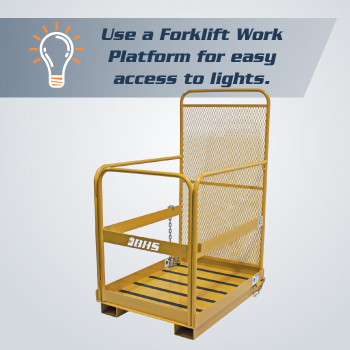We use cookies to make your experience better. To comply with the new e-Privacy directive, we need to ask for your consent to set the cookies. Learn more.
Energy Savings for Green Warehousing Operations
Whether you run a warehouse, a cold-storage facility, or a regional distribution center, odds are you’re pursuing aggressive sustainability goals. The fastest way to reduce your business’ carbon footprint is to invest in energy efficiency — and that doesn’t necessarily mean costly redesigns.
Here are a few ways you can cut your warehouse energy bill while also contributing to a greener overall operation:
-
Perform a lighting audit and de-lamp where possible. Of course you need to provide employees with sufficient lighting to ensure a safe workplace. To quote OSHA standard 1910.37(b), “Lighting and marking must be adequate and appropriate.” But many warehouses use more lighting than they need. A detailed lighting audit can reveal areas that would be safely bright with a single fixture, rather than the three or four that are currently installed. Remove unnecessary lighting.
-
Stay up to date on HVAC maintenance. Something as simple as a dirty filter can make your whole HVAC system work much, much harder, expending way more energy than necessary. Create a maintenance schedule that includes changing filters, and be sure to follow it closely.
-
Upgrade to high-efficiency lighting. According to the U.S. Environmental Protection Agency’s Energy Star program, warehouse looking to slash electricity bills need to upgrade their lighting. Try replacing T12 fluorescent bulbs with high-efficiency Super T8 or T5 lighting. Where possible, use LED lamps.
-
Clean light fixtures regularly. As bulbs accumulate dust, they cast less light, leading to superfluous fixture installation. By regularly cleaning lights, warehouse managers can keep their lighting needs to an absolute minimum. Provide employees with a Forklift Work Platform to grant easy access to fixtures on high ceilings without investing in a free-standing personnel lift.

Even a 5-percent reduction in energy costs can make a big difference to a company’s bottom line. Heating and lighting are the two biggest energy-sucks in the warehouse, which pulls down profits company-wide. By one estimate, warehousing services make up nearly 10 percent of overall revenue for companies that depend on the supply chain.
There’s no time like the present for boosting energy savings in every warehouse you operate. Just ask your accounting department; better yet, ask the generations that will inherit the environment that we leave them.
For more information on improving energy efficiency at a warehouse, see the EPA Energy Star guide to best practices, available for download here.
References:
Pierce, Freddie. “Save Energy in Your Warehouse to Meet Green Initiatives.” SupplyChainDigital. BizClik Media Ltd., 31 Jan. 2013. Web. 13 Mar. 2019.
“Warehouse Facility Improvement Best Practices Checklist.” EnergyStar. U.S. Environmental Protection Agency, 9 Sept. 2016. PDF. 13 Mar. 2019.
